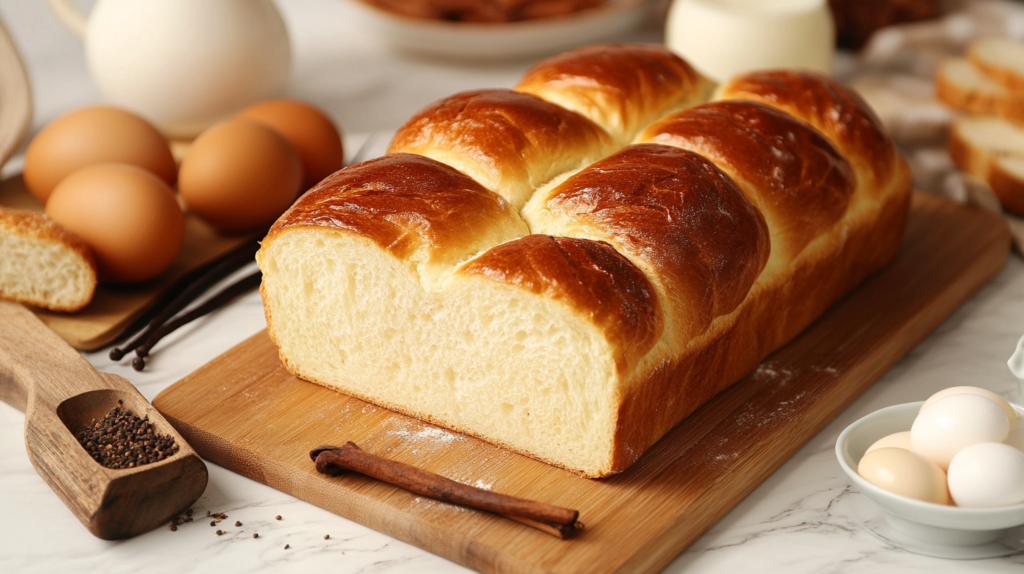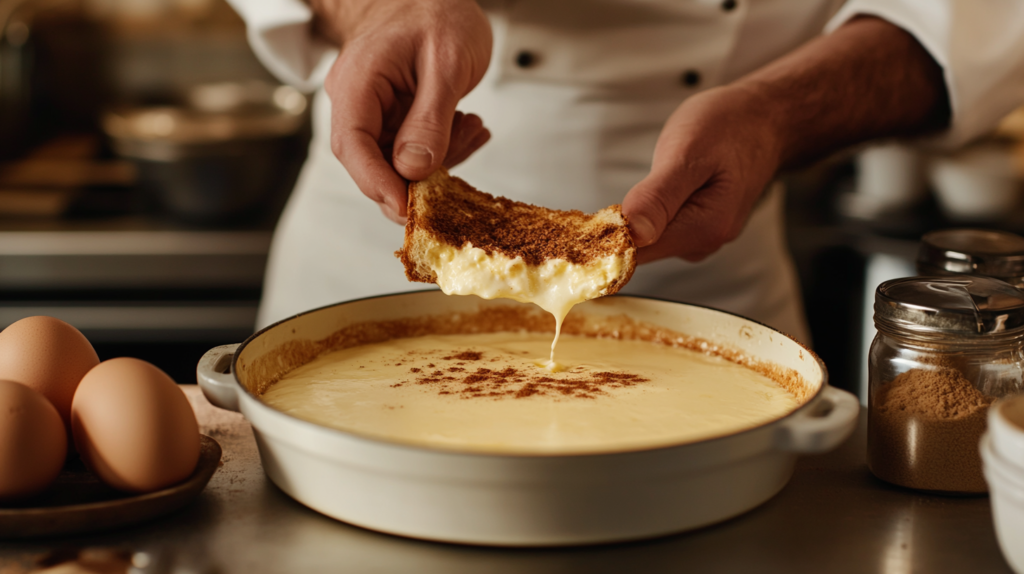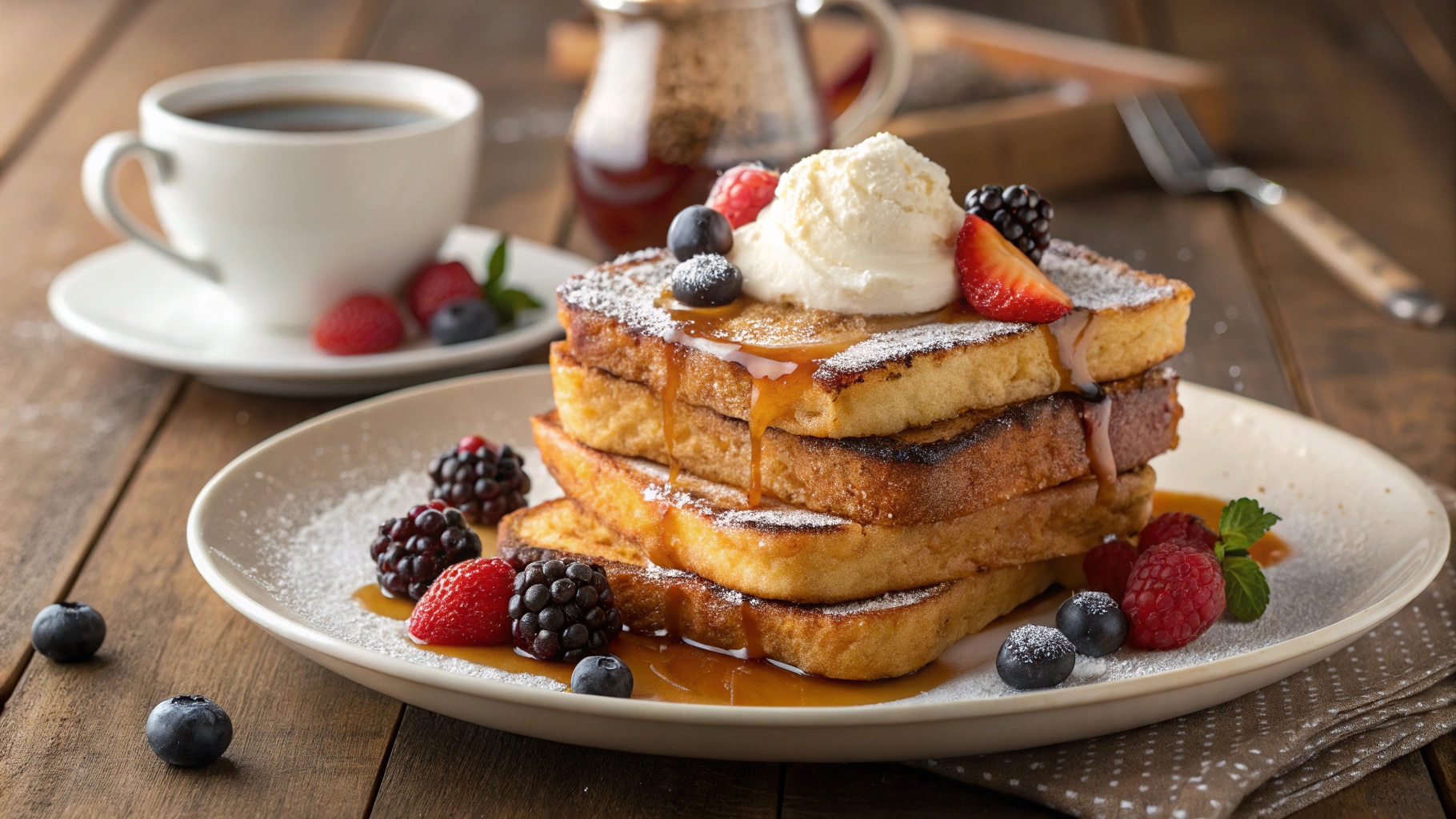How to make French toast crisp and delicious? 🥞 It’s easier than you think! That golden-brown crust, the soft custardy center, and syrup drizzling down the sides French toast is a breakfast classic that’s loved worldwide. 😋 But not all French toast is created equal. Why are some slices irresistibly crispy while others turn out soggy or bland? Let’s uncover the secrets to mastering this timeless dish and elevate your breakfast game!
Table of Contents
“The secret to amazing French toast lies in the balance of texture, flavor, and technique.”
The History of French Toast
Origins of French Toast: Not Just French
Surprise! French toast didn’t actually originate in France. This dish dates back to ancient Rome, where cooks dipped stale bread into a mixture of milk and eggs before frying it. They called it “Pan Dulcis.” Over time, the concept spread across Europe, with each country adding its twist.
So, why is it called “French” toast? Some say it’s because the French perfected the recipe, turning stale bread into a masterpiece. Others point to the term “pain perdu,” meaning “lost bread,” which refers to using bread that would otherwise go to waste.
How French Toast Became a Breakfast Staple
Fast forward to today, and French toast is a beloved comfort food worldwide. From diner menus to fancy brunch spots, it’s a dish that brings people together. Whether you top it with syrup, fruits, or whipped cream, it’s a blank canvas for creativity and that’s what makes it so special.
What Makes French Toast “Good”?
The Perfect Texture: Soft Inside, Crisp Outside
Let’s be honest: the texture can make or break French toast. The goal is simple crispy edges that give way to a soft, custardy interior. If your toast turns out soggy or rubbery, something’s gone wrong. But don’t worry; we’ll cover how to nail it every time.
Balancing Sweetness and Flavor
Ever had French toast that was too bland or overly sweet? It’s all about balance. A hint of cinnamon, a splash of vanilla, and the right amount of sweetness can take your French toast from “meh” to “wow.” Think of it as a symphony every ingredient plays its part.
Common Problems with French Toast
Soggy French Toast: Causes and Fixes
Soggy French toast is the ultimate letdown. The culprit? Too much liquid or not enough heat. If your bread is dripping with custard before it hits the pan, it’ll soak up oil instead of crisping up. Solution? Lightly dip your bread (don’t drown it!) and cook over medium heat to allow the custard to set without burning.
Uneven Cooking: Why It Happens
Ever flipped your French toast only to find one side perfectly golden and the other side pale? Uneven cooking often happens when the pan isn’t preheated or the bread isn’t soaked evenly. Make sure your pan is nice and warm, and rotate the bread in the custard for even coverage.
Lack of Flavor: Missing the Mark
Bland French toast is just sad. If you skip the spices or use plain milk, you’re leaving a lot of flavor potential untapped. Always add a pinch of cinnamon, a splash of vanilla extract, and a dash of nutmeg for a flavor boost.
Choosing the Right Ingredients

| Ingredient | Quantity |
|---|---|
| Bread (Brioche, Challah, or French Bread) | 4–6 slices |
| Eggs | 2 large |
| Milk (Whole or Cream) | 1 cup |
| Sugar | 1–2 tablespoons |
| Vanilla Extract | 1 teaspoon |
| Cinnamon | ½ teaspoon |
| Nutmeg (Optional) | Pinch |
| Butter (for cooking) | 2 tablespoons |
The Best Bread for French Toast
Not all bread is created equal when it comes to French toast. The best options? Brioche, challah, or even a good French baguette. Why? These breads are sturdy, absorb the custard well, and deliver a rich flavor. Avoid thin, pre-sliced sandwich bread it’ll fall apart faster than a house of cards.
Egg Mixture: Essential Ingredients and Ratios
The egg mixture is the heart of French toast. A standard ratio is one egg per half cup of milk, but feel free to tweak it for a richer custard. Want a creamier texture? Swap out milk for half-and-half or heavy cream.
Sweeteners and Spices to Enhance the Flavor
A dash of cinnamon and a splash of vanilla go a long way. You can also add a pinch of sugar or maple syrup to the mix for sweetness. Feeling adventurous? Try cardamom or a hint of orange zest for a unique twist.
Step-by-Step Guide to Making the Perfect French Toast

Ready to make French toast that will leave everyone asking for seconds? Follow this simple, step-by-step guide and you’ll be flipping golden slices like a pro in no time!
1. Prepping Your Bread: Why Stale Bread Works Best
Here’s a neat trick: stale bread is your best friend when it comes to French toast. Why? Fresh bread tends to fall apart when dipped in the egg mixture, while stale bread soaks up the custard without turning to mush. If your bread is fresh, don’t worry! You can lightly toast it or leave it out overnight to dry.
2. Crafting the Perfect Egg Mixture
This is where the magic begins. Crack your eggs into a bowl and whisk until smooth. Add milk (or cream), sugar, vanilla extract, cinnamon, and a pinch of nutmeg. Whisk everything together until well combined. Want to level it up? Replace some of the milk with melted ice cream for a sweet and creamy boost. 🎉
“Pro Tip: Mix your ingredients thoroughly to avoid clumps of spice or egg whites in the mixture.”
3. Dipping and Coating: Achieving Even Coverage
Pour your egg mixture into a shallow dish or pie plate. This makes it easier to dip your bread evenly. Take one slice at a time and dip it quickly don’t let it sit too long, or it’ll get soggy. Flip it over to coat the other side, and you’re good to go!
4. Cooking Techniques: Heat, Timing, and Utensils
Heat a non-stick pan or griddle over medium heat and add a knob of butter. Once it melts and starts to foam, place your dipped bread in the pan. Cook for 2–3 minutes on each side or until golden brown. Avoid high heat it might burn the outside while leaving the inside uncooked. Use a spatula to flip the slices carefully.
“The perfect French toast should be golden brown with crispy edges. Think of it as toast’s fancier, fluffier cousin!”
Variations of French Toast
French toast is like a blank canvas there are endless ways to customize it! Whether you’re in the mood for something sweet or savory, there’s a version for you. Let’s explore some delicious twists.
Sweet Variations: Cinnamon, Vanilla, and Fruit Toppings
For a classic sweet version, stick to cinnamon and vanilla in the egg mixture. Top it with fresh fruits like berries, banana slices, or a dusting of powdered sugar. Drizzle with maple syrup or honey for that extra sweetness. Feeling indulgent? Add whipped cream or chocolate chips. 🍓🍫
Savory French Toast: A Unique Twist
Who says French toast has to be sweet? Try a savory version by skipping the sugar and spices in the custard. Add salt, pepper, and grated cheese instead. Top with avocado slices, a fried egg, or even smoked salmon. It’s like breakfast and brunch had a delicious baby!
Tips and Tricks for Mastering French Toast
The Role of Butter: Adding Richness Without Burning
Butter adds richness and flavor, but it can burn quickly if you’re not careful. To prevent this, use a combination of butter and oil (like vegetable or canola oil). The oil raises the smoke point, while the butter keeps that delicious flavor.
Keeping French Toast Warm and Fresh
Cooking for a crowd? Keep your French toast warm by placing it on a baking sheet in a 200°F (90°C) oven. This trick ensures every slice stays hot and ready to serve without losing its texture.
Experiment with Bread Types
While brioche and challah are classic choices, don’t be afraid to get creative. Try croissants, cinnamon raisin bread, or even sourdough for a unique twist. Each type of bread adds its personality to the dish.
| Component | Amount |
|---|---|
| Calories | 190 |
| Protein | 6g |
| Fat | 7g |
| Carbohydrates | 24g |
| Sugar | 6g |
“French toast is the perfect combination of comfort and creativity. There’s no wrong way to enjoy it!”
Serving Suggestions and Pairings
French toast is a showstopper on its own, but pair it with the right sides and toppings, and you’ve got a full-on breakfast extravaganza. Let’s explore some mouthwatering combinations that will make your French toast meal unforgettable. 🍽️
Best Syrups and Toppings for French Toast
Syrup is the classic choice, but why stop there? Try drizzling your French toast with:
- Maple Syrup: A timeless favorite for a reason.
- Honey: A natural and subtly sweet alternative.
- Nutella: Because chocolate makes everything better.
- Fresh Fruit Compote: Blueberries, strawberries, or peaches simmered with a little sugar and lemon juice.
And don’t forget the toppings! Sprinkle powdered sugar, dollop whipped cream, or add a handful of nuts for crunch.
Ideal Side Dishes and Beverages
To balance the sweetness of French toast, pair it with savory sides like crispy bacon, scrambled eggs, or sausages. Looking for lighter options? A side salad with vinaigrette or a bowl of Greek yogurt with granola works wonders. As for beverages, coffee, tea, or a glass of freshly squeezed orange juice completes the experience.
Troubleshooting: Fixing French Toast Mishaps
Not every batch of French toast turns out perfect, and that’s okay! Here’s how to troubleshoot common problems and save your dish.
How to Save Overcooked or Undercooked Toast
Overcooked toast? Slice off the edges and top it with extra syrup or fruit to mask any dryness. Undercooked? Pop it into a 350°F (175°C) oven for 5–7 minutes to finish cooking without burning.
What to Do If Your Toast Sticks to the Pan
If your toast is sticking, your pan might not be greased enough or hot enough. Next time, use a generous amount of butter or oil and preheat the pan properly. If it’s already stuck, gently loosen it with a spatula and cover any torn areas with toppings no one will notice!
FAQs About French Toast
Can You Make French Toast Ahead of Time?
Absolutely! You can prepare the egg mixture the night before and store it in the fridge. For the toast itself, cook it fully, then reheat in the oven or toaster the next morning. If you’re really planning ahead, French toast freezes beautifully just wrap individual slices and freeze for up to a month.
Is French Toast Healthy?
It can be! Opt for whole-grain bread, use low-fat milk, and reduce sugar in the egg mixture. Toppings like fresh fruit and Greek yogurt also add nutrition without loading on the calories.
What Are the Best Alternatives for Dairy or Eggs?
Going dairy-free? Use almond, oat, or soy milk. Egg-free? Try a mixture of mashed banana, flaxseed meal, or even silken tofu as a custard substitute. These swaps are great for vegan or allergen-friendly French toast.
Conclusion: Perfecting Your French Toast Game
So, what’s the trick to good French toast? It’s all about the little things using the right bread, nailing the egg mixture, and cooking it to golden perfection. Whether you’re keeping it classic or getting creative with toppings, French toast is the ultimate crowd-pleaser that’s as versatile as it is delicious.
“French toast isn’t just food; it’s a mood. Whether you’re indulging in a lazy Sunday breakfast or impressing brunch guests, it’s the kind of dish that makes memories.”
Now that you’re armed with all the tips and tricks, it’s time to get cooking! Experiment, have fun, and don’t forget to share your creations with friends and family. Bon appétit! 🍞🍳
Adore French toast? Elevate it with a unique twist! Explore our guide on crafting the ultimate French toast sandwich for a fresh and creative take on this beloved breakfast classic. 🥪✨
People also ask
What is the most common mistake when making French toast?
Why is a Monte Cristo Sandwich called that?

Crisp & Delicious French Toast
Equipment
- Large Mixing Bowl: For whisking the egg mixture.
- Whisk or Fork: To blend the eggs and spices.
- Shallow Dish or Pie Plate: For dipping the bread slices.
- Non-Stick Skillet or Griddle: For pan-frying the French toast.
- Spatula: To flip and remove the toast.
- Measuring Cups and Spoons: For accurate ingredient portions.
- Cooling Rack (Optional): To keep the toast crisp while serving.
Ingredients
- 4 slices thick-cut bread brioche, challah, or French bread work best
- 3 large eggs
- 1/2 cup whole milk or heavy cream for an extra rich flavor
- 1 teaspoon vanilla extract
- 1/2 teaspoon ground cinnamon
- A pinch of salt
- 2 tablespoons granulated sugar optional, for added crisp and sweetness
- Zest of 1 orange optional, for a citrusy note
- 2-3 tablespoons butter or oil for frying
- Powdered sugar for dusting (optional)
- Maple syrup for serving
Instructions
- Prepare the Egg Mixture:
- In a large mixing bowl, whisk together the eggs, milk, vanilla extract, ground cinnamon, salt, and (if using) the granulated sugar and orange zest until the mixture is smooth and well combined.
- Preheat the Skillet:
- Place your non-stick skillet or griddle over medium heat. Add butter or oil to lightly coat the surface.
- Dip the Bread:
- Pour a portion of the egg mixture into a shallow dish (or use the bowl if it’s wide enough). Dip each bread slice into the mixture, allowing it to soak for about 20–30 seconds on each side. Ensure the bread is well-saturated but not overly soaked to avoid sogginess.
- Cook the Toast:
- Place the dipped bread slices onto the preheated skillet. Cook for about 3–4 minutes on each side, or until each side is golden brown and crisp. Adjust the heat as needed to ensure even cooking without burning.
- Drain & Serve:
- Transfer the cooked French toast to a cooling rack (if available) to maintain its crispness. Dust lightly with powdered sugar if desired, and serve immediately with maple syrup, fresh fruit, or your favorite toppings.
- Details
- Prep Time: 10 minutes
- Cook Time: 8–10 minutes
- Total Time: 18–20 minutes
- Yield: 4 servings
- Category: Breakfast, Brunch
- Method: Pan-frying
- Cuisine: American, Continental
- Diet: Vegetarian (adaptable to gluten-free using gluten-free bread)
- Keywords
- French toast, crispy, breakfast, brunch, easy recipe, indulgent, crisp exterior, custardy interior
- Nutrition (Per Serving Estimate)
- Based on using whole milk, brioche bread, and butter; values may vary with ingredient choices:
- Serving Size: 1 slice
- Calories: Approximately 250–300 kcal
- Sugar: ~8 g
- Sodium: ~350 mg
- Fat: ~12 g
- Saturated Fat: ~6 g
- Unsaturated Fat: ~6 g
- Trans Fat: 0 g (trace amounts may occur naturally in butter)
- Carbohydrates: ~30 g
- Fiber: ~1 g
- Protein: ~9 g
- Cholesterol: ~150 mg
Notes
Pre-Toasting Option: For an extra layer of crisp, lightly toast the bread before dipping it in the egg mixture.
Batch Cooking: Avoid overcrowding the skillet; cook in batches if necessary to maintain a consistent temperature and crisp texture.
Customization: Experiment with different spices (like nutmeg) or substitute a portion of the milk with cream cheese for a tangy twist.
Serving Tip: Keep finished slices in a warm (200°F) oven on a cooling rack to preserve their crispiness until serving.
Enjoy your deliciously crisp French toast as a memorable breakfast or brunch treat!

